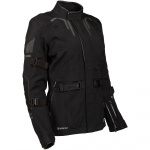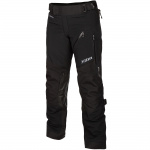Before a recent tour to Scotland I wanted something that was going to keep me dry if there was a downpour and ventilated if I was lucky enough to catch some warm weather. I immediately thought of a laminated waterproof jacket.
That seemed a fairly straightforward demand, but I found myself facing a disappointing selection of true laminated jackets for women. By true laminated, I mean a jacket where the waterproof membrane is bonded to the outer material.
I specifically wanted bonded laminate because it would keep the rain out and let me start the next day’s ride knowing I wouldn’t be putting on a soggy and heavy kit that still wasn’t dry.
Having previously ridden in kit with removable membranes, laminated kit would mean I wouldn’t have to decide each day whether to go with the waterproof membrane in or out.
After poking around the limited choice, I settled on the Klim Ladies Altitude Gore-Tex Jacket. It wasn’t the cheapest, but it wasn’t the most expensive either. The most affordable laminated ladies jacket at the time was Oxford’s Mondial at around £300, and then Rukka and Held had options for over £1000. This Klim jacket was £750.
When I tried the Altitude jacket on it immediately felt well tailored for my body shape. I’m not large-chested, but I have broad shoulders. Usually a size 12 would suit, but I went up to a size 14 to leave room for thick warm layers underneath. I don’t mind having a baggier fit on warm days.
The Klim Altitude jacket doesn’t come with any form of thermal liner, which I didn’t mind. It meant I didn’t have the faff of zipping and buttoning in another layer. I already had layers I trusted to keep me warm, so having the outer independent was a good thing for me.
As well as the trusted Gore-Tex membrane, the outer has 600-denier Cordura overlays on the shoulders, and perforated goatskin patches on the elbows and on the upper arms. The CE protection rating is a basic pass at Level A.
In addition, there is goatskin trim on the front edge of the main two pockets, on the rims of the sleeve-ends, and around the rim of the neck. These made for nice soft edges for added comfort and prevented any nasty chafing.
This jacket comes with D3O armour in the shoulders and elbows and a D3O Viper CE back protection. It all passes the CE standard at the basic Level 1, which is the case for the armour in the majority of jackets.
I found this jacket has a good amount of storage for all my bits and bobs, but not so many that I lost track of where I put things.
The two zippered hand pockets on the front have water-sealed zips. The right hand pocket has two sub-pockets, which I found handy for storing the case for my Auritech earplugs, rather than leaving it loose in the bottom of the pocket.
The left-hand pocket has a strap with a clip to keep house keys safe in case you forget to close the zip.
There is also an emergency ID pocket on the forearm. You could store a credit card in there or some change. I didn’t use it, but for some it might be a neat solution rather than having to dig around for your change for tolls.
A secret pocket inside the back protector pocket for travellers who want to keep their ID papers safe is another forward-thinking idea from Klim. It’s not something I needed on my trip, but it’s good to know it's there.
There are two good-sized internal pockets as well, one at chest height on the left and one at hip height on the right. Either would suit a phone, although I had mine mounted to my bike. I kept my watch in one pocket while riding and stored my slim wallet in the other.
The fit of this jacket is very feminine. It is well tailored to a typical hourglass figure and has plenty of adjustment, from straps on either side of the waist and two on each arm - one around the forearm and one around the bicep.
I wore a long-sleeved DXR Warmcore base layer under the jacket, sometimes with a Keis heated jacket for extra warmth.
This combination fitted well, although I did find it quite snug on the forearm, perhaps due to the pocket on the Keis jacket that houses a connection for heated gloves. This made it snug for flexing while off the bike (like putting in my ear plugs), but once on the move this didn’t bother me.
There is also a zipper expansion at the hem so you can give yourself more room if you are particularly active on the bike. I like this feature on jackets, because it means I have good room for my hips and backside. I don’t like it when a jacket is tight around here, it is just uncomfortable and gives me no flexibility.
For even more flexibility at the hip, the main zipper at the front is double-headed so you can unzip up from the bottom. This is another feature I love on any kind of jacket, though you have to remember to pull the zip down again if it rains.
The wide-opening cuffs allowed my winter gloves to fit underneath before zipping them up. The velcro tabs gave me extra adjustment, meaning I could tighten the cuffs even more to make for a snug seal to keep to the chill from whooshing up my arm.
My main gripe with this jacket though, is the neck opening, which is surprisingly snug. It is fine for me when I don’t have a layer underneath to keep my neck warm. But when I add a thermal layer that zips up around my neck it becomes hard to keep the velcro tab stuck down.
To help you decide if this criticism will be relevant to you, I measured my neck and it has a 35cm circumference.
If you want more room, and airflow, around the neck there are two loops that secure to hooks on the outside of the jacket so you can keep the collar open.
I found this really fiddly. You have to make sure the loops are fully seated into the hooks to make sure they don’t pop out. This is definitely something to sort out before you set off as it would be very hard to do on the move. However, when you do get it secure, there is no question over the amount of airflow you get when the neck is open.
One of the inevitable compromises of a laminated jacket over one with a removable liner is the risk of overheating on a hot day. I was fortunate enough to have a spell of warm weather on my trip, which gave me the opportunity to test the ventilation.
Two horizontal vents on the front, just above the waist adjustment straps, deliver the main intake of air at the front. Then two opposing vertical exhaust vents on the back around the hip take warm air away.
The cuffs have double-headed zips too, which allowed me to pull one zip back down towards the cuff and open up a vent for air to flow up my arms.
The air flow up my arms helped to keep my underarms from getting too hot and the lateral vents on the front of the jacket helped channel air around my body and keep my core cool.
On some occasions I became too cool, which meant having to zip some or all of them up. I find it difficult to maintain a comfortable temperature and generally, it is much harder for me to stay warm than to cool off.
Compared to other jackets I have worn where the waterproof membrane can be taken out, this gave less airflow. However, never at any point did I feel sticky and uncomfortable while wearing the Klim Altitude Gore-Tex jacket.
All the zips on the vents are water-sealed and I never had any water come through to the inside. The main zipper has a stormflap with an ingress gutter on the inner flap. This is held down with velcro patches and a press stud at the bottom.
The waterproofing performance didn’t let me down once in this jacket. On my Scotland trip, I rode through heavy rain for at least an hour and not a drop leaked through. By the time I got to my destination an hour or so later it had brightened up and my kit was dry again.
I have ridden in some very heavy rain since returning from the trip, including hailstones on my commute to and from work, and the Klim Altitude jacket has kept me dry throughout.
Inside the base of the jacket there is a long attachment zip to connect to the matching Klim Ladies Altitude Gore-Tex trousers which I have also tried and will review separately. I found it easy to connect the jacket to the trousers because I could see the ends of the zips to feed them into each other.
When they were connected, I found both jacket and trousers to be comfortable when worn in combination.
Before even riding in this jacket, just committing to it meant I immediately felt a weight of anxiety lift. I was glad to be taking a good quality jacket to keep me warm and dry on my eight-day trip.
The Klim Altitude lived up to my expectations through every single one of the 1,440 miles I did on my trip and this is most definitely a jacket I would recommend.

Klim Ladies Altitude Textile Jacket







